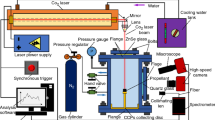Abstract
This paper presents burning rates as a function of pressure of several propellant formulations based on ammonium perchlorate (AP) and hydroxyl-terminated polybutadiene cured by isophorone diisocyanate, many of which exhibit significantly low (nearly zero or negative) values of the pressure exponent of the burning rate in distinct pressure ranges, termed as plateau burning rate trends. The propellants contain a bimodal distribution of AP particles with the size of the coarse and fine particles within narrow ranges whose mean values are widely separated. Two mean sizes of fine particles were considered for the propellant formulations in the present work, namely, 5 and 20 µm. These choices are based on the mid-pressure extinction behavior exhibited by the matrix of fine AP and binder contained in the propellants but when tested alone over a wide range of fine AP size and pressure. The propellants that include the fine AP/binder matrixes exhibiting a mid-pressure extinction, in turn, exhibit the plateau burning rate trends within the corresponding pressure ranges. A plateau is also observed at elevated pressures in the burning rates of some formulations, which is related to the diminishing relative importance of the near-surface leading-edge region of the oxidizer/fuel diffusion flame in the gas-phase combustion zone. The choice of the coarse AP size influences the exact pressure range within the mid-pressure extinction domain of the matrix where the propellant exhibits the plateau burning rate trends.
Similar content being viewed by others
References
G. P. Sutton, Rocket Propulsion Elements, John Wiley, New York (1992).
M. R. Denison and E. Baum, “A simplified model of unstable burning in solid propellants,” Amer. Rocket Soc. J., 31, 1112–1122 (1961).
E. K. Bastress, “Modification of the burning rates of ammonium perchlorate solid propellants by particle size,” Ph. D. Thesis, Princeton Univ., Princeton (1961).
J. A. Steinz, P. L. Stang, and M. Summerfield, “Effects of oxidizer particle size on composite solid propellant burning: Normal burning, plateau burning, and intermediate pressure extinction,” Aerospace and Mech. Sci. Report No. 810, Guggenheim Laboratories for Aerospace Propulsion Sciences, Princeton Univ., Princeton (1967).
M. Summerfield, G. S. Sutherland, M. J. Webb, et al., “Burning mechanism of ammonium perchlorate propellants,” in: M. Summerfield (ed.), Progress in Astronautics and Aeronautics, Vol. 1: Solid Propellant Rocket Research, Chapter 6, Academic Press, New York (1960), pp. 141–182.
R. R. Miller “Anomalous ballistic behavior of reduced smoke propellants with wide AP distributions,” in: Proc. of the 15th JANNAF Combustion Meeting, Publ. No. 281(2), Chem. Propuls. Inform. Agency, Laurel (1979), pp. 265–269.
R. L. Foster and R. R. Miller, “The influence of the fine AP/binder matrix on composite propellant ballistic properties,” in: Proc. of the 17th JANNAF Combustion Meeting, Publ. No. 329(3), Chem. Propuls. Inform. Agency, Laure (1980), pp. 91–104.
J. P. Renie, J. A. Condon, and J. R. Osborn, “Oxidizer size distribution effects on propellant combustion,” AIAA J., 17, No. 8, 877–883 (1979).
C. W. Fong and R. F. Smith, “The relationship between plateau burning behavior and ammonium perchlorate particle size in HTPB-AP composite propellant,” Combust. Flame, 67, 235–247 (1987).
M. W. Beckstead, R. L. Derr, and C. F. Price, “A model of composite solid-propellant combustion based on multiple flames,” AIAA J., 8, No. 12, 2200–2207 (1970).
J. Yin, B. Li, K. Wang, and B. Chen, “Combustion mechanism of a negative pressure-exponent composite solid propellant,” J. Propuls. Power, 8, No. 1, 37–44 (1992).
S. R. Chakravarthy, E. W. Price, and R. K. Sigman, “Binder melt flow effects in the combustion of AP-HC composite solid propellants,” in: 31st AIAA/ASME/SAE/ASEE Joint Propulsion Conference and Exhibit, AIAA Paper No. 95-2710, San Diego (1995).
S. R. Chakravarthy, J. M. Seitzman, E. W. Price, and R. K. Sigman, “Intermittent burning of ammonium perchlorate-hydrocarbon binder monomodal matrixes, sandwiches, and propellants,” J. Propuls. Power, 20, No. 1, 101–109 (2004).
S. R. Chakravarthy, E. W. Price, R. K. Sigman, and J. M. Seitzman, “Plateau burning behavior of ammonium perchlorate sandwiches and propellants at elevated pressures,” J. Propuls. Power, 19, No. 1, 56–65 (2003).
S. R. Chakravarthy, E. W. Price, and R. K. Sigman, “Mechanism of burning rate enhancement of composite solid propellants by ferric oxide,” J. Propuls. Power, 13, No. 4 471–480 (1997).
A. M. Varney and W. C. Strahle, “Experimental combustion studies of two-dimensional ammonium perchlorate-binder sandwiches,” Combust. Sci. Technol., 4, 197–208 (1972).
T. L. Boggs and D. E. Zurn, “The deflagration of ammonium perchlorate-polymeric binder sandwich models,” ibid., pp. 279–292.
Author information
Authors and Affiliations
Additional information
__________
Translated from Fizika Goreniya i Vzryva, Vol. 43, No. 4, pp. 73–81, July–August, 2007.
Rights and permissions
About this article
Cite this article
Banerjee, S., Chakravarthy, S.R. Ammonium perchlorate-based composite solid propellant formulations with plateau burning rate trends. Combust Explos Shock Waves 43, 435–441 (2007). https://doi.org/10.1007/s10573-007-0059-5
Received:
Issue Date:
DOI: https://doi.org/10.1007/s10573-007-0059-5




